Best Remote Control Golf Trolleys 2025
A look at the most cutting-edge electric trolleys around that can be controlled at your fingertips


Golf can be hard enough at times, so any help is usually welcome. The best golf carts do just that. They allow us the enjoyment of walking the course without having to carry our bags, saving energy and hopefully a few shots along the way.
Electric golf trolleys are a tech-friendly alternative to the best golf push carts, with some models featuring remote control functionality. Armed with a pocket-sized handset you can control the speed and direction of the trolley without ever having to guide it by hand - there are even some models that will follow you as you walk the fairways. Unsurprisingly these models are more expensive but they do offer you a greater degree of freedom - a hands-free experience can be a real game changer for some golfers.
In this guide we’ve selected some of the best electric golf trolleys on the market, chosen from the many models we’ve tested. By presenting a number of options, all with full reviews, we’ll hopefully aid you in your hunt for the best remote control golf trolley for you. Alternatively, after reading this guide you may decide that ‘going remote’ isn’t for you after all. If that’s the case we also have an extensive guide to best golf push trolleys, which still deliver the many advantages of not having to carry a bag while walking a course but without the added expense of their electric counterparts.
The Quick List
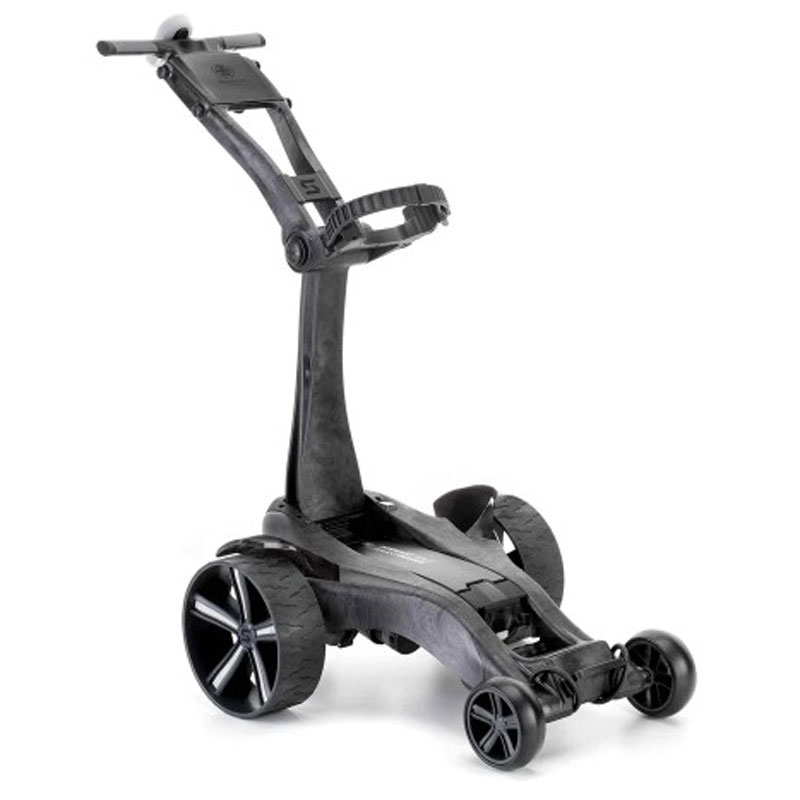
The Vertx Remote features the familiar Stewart Golf design, but it's the new technology that makes up the trolley's DNA that creates a class-leading remote control experience.

A comprehensive and enjoyable remote-controlled golf trolley. The remote-control functionality works as well as ever and the Performance Plan makes for a superb GPS experience.

An excellent entry-level example of a remote electric trolley. It may not have as many toys as other Motocaddy models, but it offers a seamless remote experience, a compact folding mechanism and high build quality.
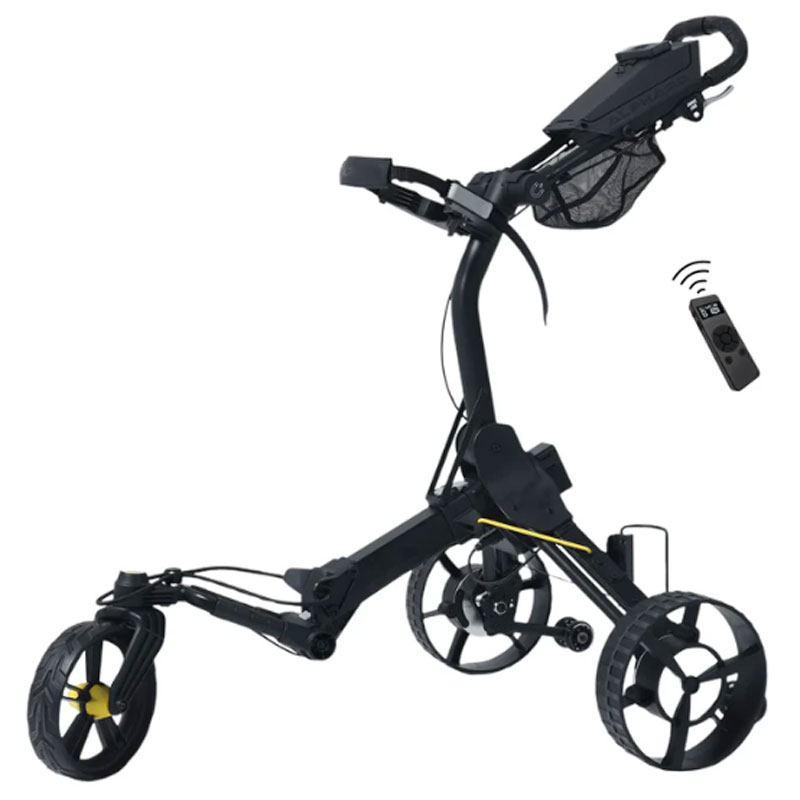
It may be heavier than most remote models but the Cybercart from Alphard offers arguably the best remote experience on the market thanks to the gyroscopic technology and low center of gravity.
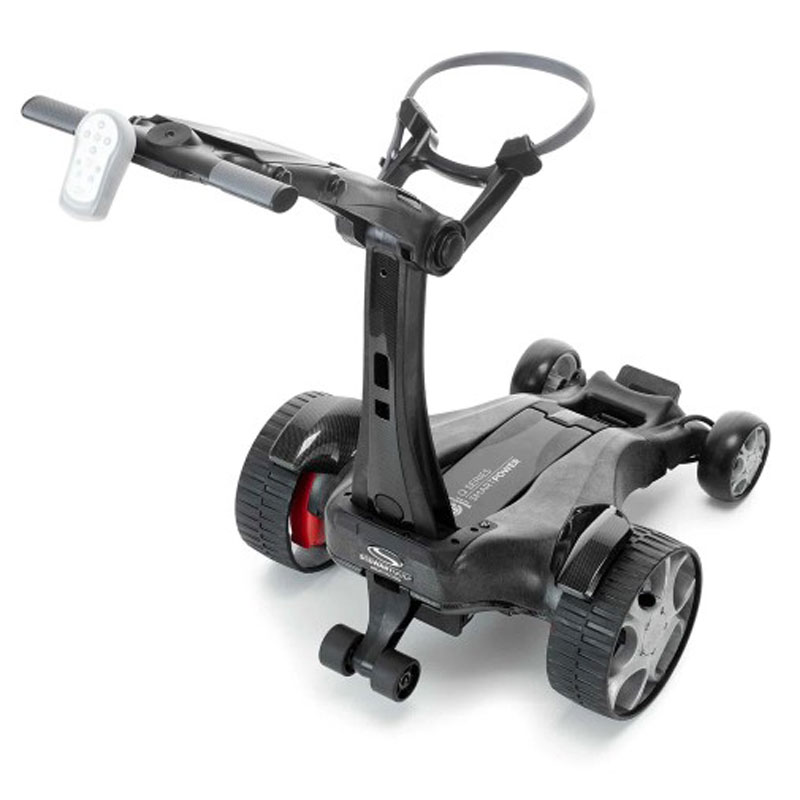
The Q Follow is great fun to use and, with practice, the switching between modes and use of the handset becomes second nature when out on the golf course.

A 5" HD portrait display means the RX12 has one of the most impressive touchscreen GPS devices we've ever seen on an electric trolley, building on an already impressive offering with the RX1.
Best Remote Control Golf Trolleys 2025
Best overall
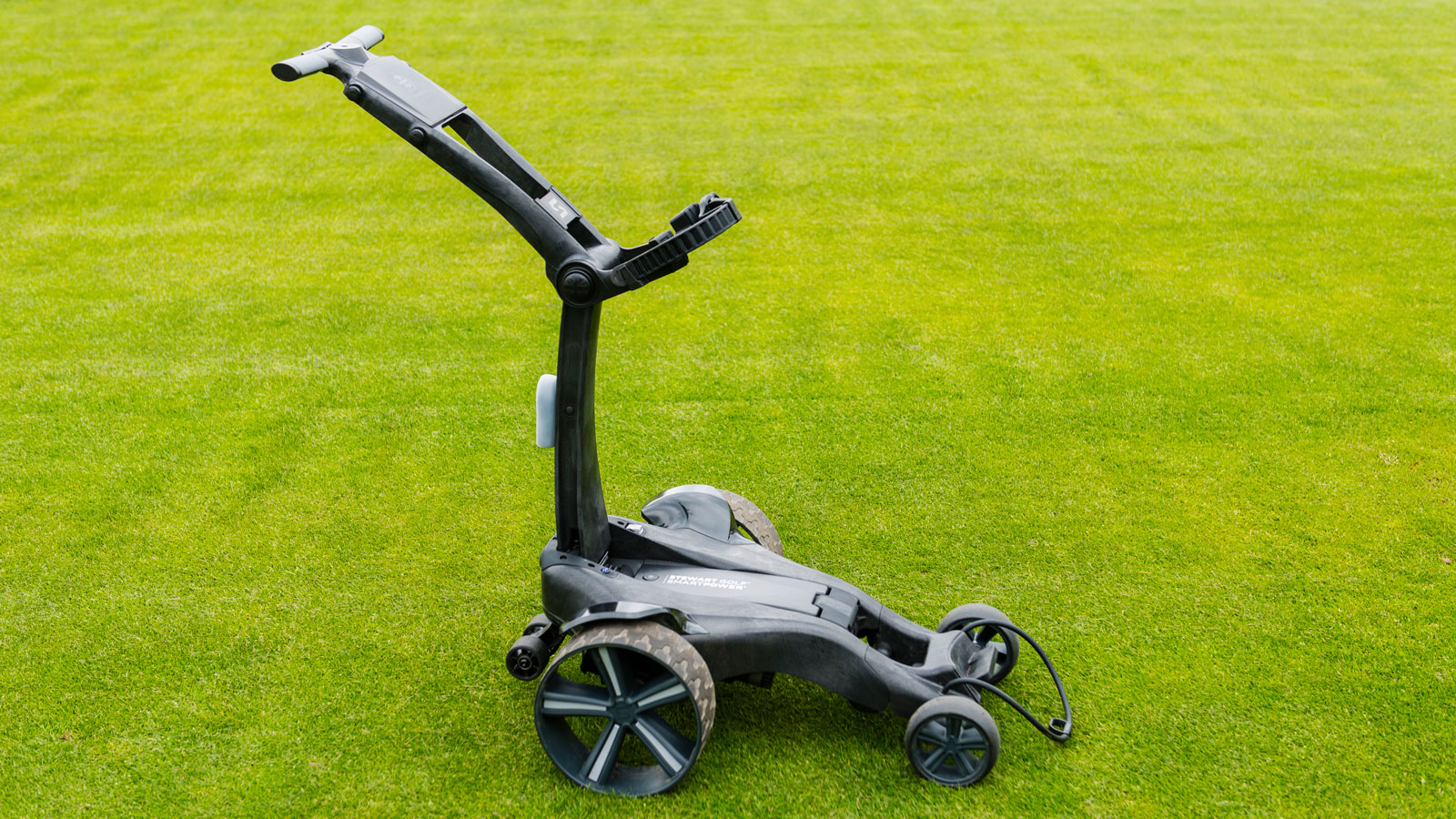
Specifications
Reasons to buy
Reasons to avoid
Stewart trolleys will be a familiar design to many and its Vertx Remote cart offers many of the design features that make them such a popular choice. Here you get its signature two-way folding system that’s easy to use and results in a relatively compact unit given it is a pretty chunky cart when compared to some of its rivals. Stewart has recognized this by incorporating a built-in carry handle. I loved how simple but effective this feature is, helping to negate some of the cart’s weight.
There’s some new technology here as well in the shape of the Active Terrain Control (ACT) operating system. During testing it allowed the trolley to navigate some challenging terrain with aplomb. It seemed that no slope was too much, leaving me seriously impressed with the ACT system. We particularly liked how it allows the cart to automatically travel at the same speed regardless of the terrain, without us having to change the power output. It meant a far more relaxing walk, knowing that I didn’t have to think about adjusting the speed whenever I hit a gradient. In short, it’s a class leader for remote functionality.
Of course any trolley, remote or otherwise, needs to be stable yet with the ability to maneuver around a course with ease. The Vertx, like all Stewart trolleys to date, uses two non-rotating front wheels. I found that it resulted in bags of stability, thanks to a nice, wide base. But it’s perfectly maneuverable as well. There are few downsides to the Vertx Remote other than its bulky dimensions but, unlike most of its rivals, it doesn’t have an embedded GPS in the handle. If this isn’t a dealbreaker it's one of the best golf carts on the market and well worth consideration.
- Read our full Stewart Golf Vertx Remote Trolley Review
Most responsive
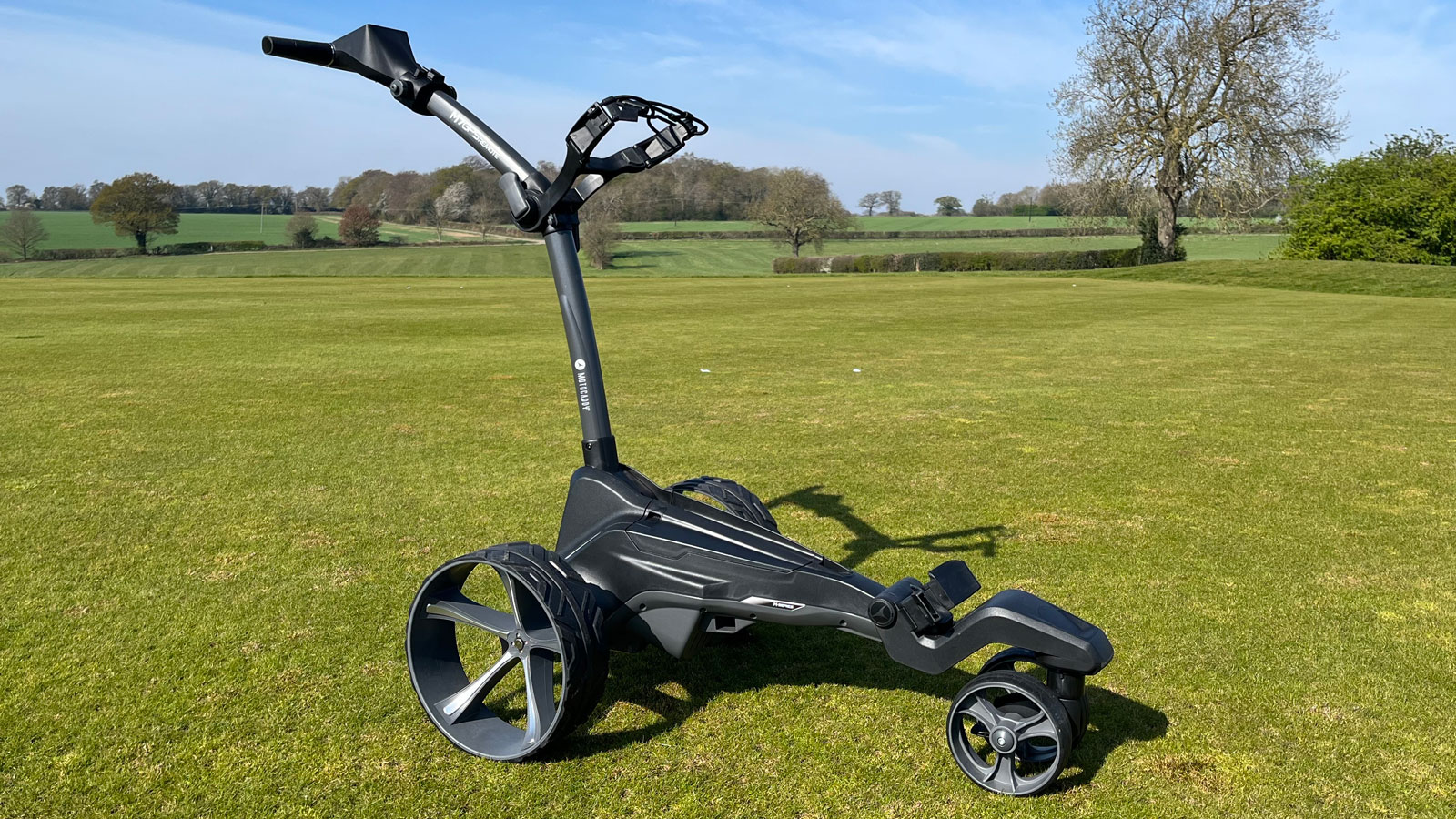
Specifications
Reasons to buy
Reasons to avoid
I really liked the previous Motocaddy M7 Remote Electric Trolley but the brand decided to go a step further with the 2025 design, implementing several improvements to the design. The most noticeable upgrade is the new cable-free battery housed in the middle of the chassis. This battery then disconnects automatically when folding the trolley down, which then reveals the charging port. It means, in theory, I never have to remove the battery from the chassis.
The folding system is similar to the previous design, a two-step system that collapses the trolley to a surprisingly compact shape, but there is now an improvement to the anti-tip wheel towards the rear. It now retracts into the chassis which saves time and means the M7 folds down compactly. In fact, despite it being an electric model, it’s comparable in size to some of the most compact trolleys on the market.
Another nice improvement in my opinion is Motocaddy has now removed the need to use a subscription service to access the full hole maps on the GPS. As such when you purchase this model you get the full power of GPS with hole maps, yardages, hazard information and more. This is then displayed on a 3.5” touchscreen that’s built in the cart’s handle. Screen quality is high and we found it easy to use even in the rain.
The M7 GPS’s remote system was equally as flawless. Using the compact remote, the cart was impressively responsive to both the speed and distance we needed it to move in. There’s a Down Hill control in play too that means it operates at a sensible speed when going downhill. The result is plenty of confidence that the cart will be there waiting for you beside your ball.
- Read our full Motocaddy 2025 M7 GPS Remote Electric Trolley
Best value
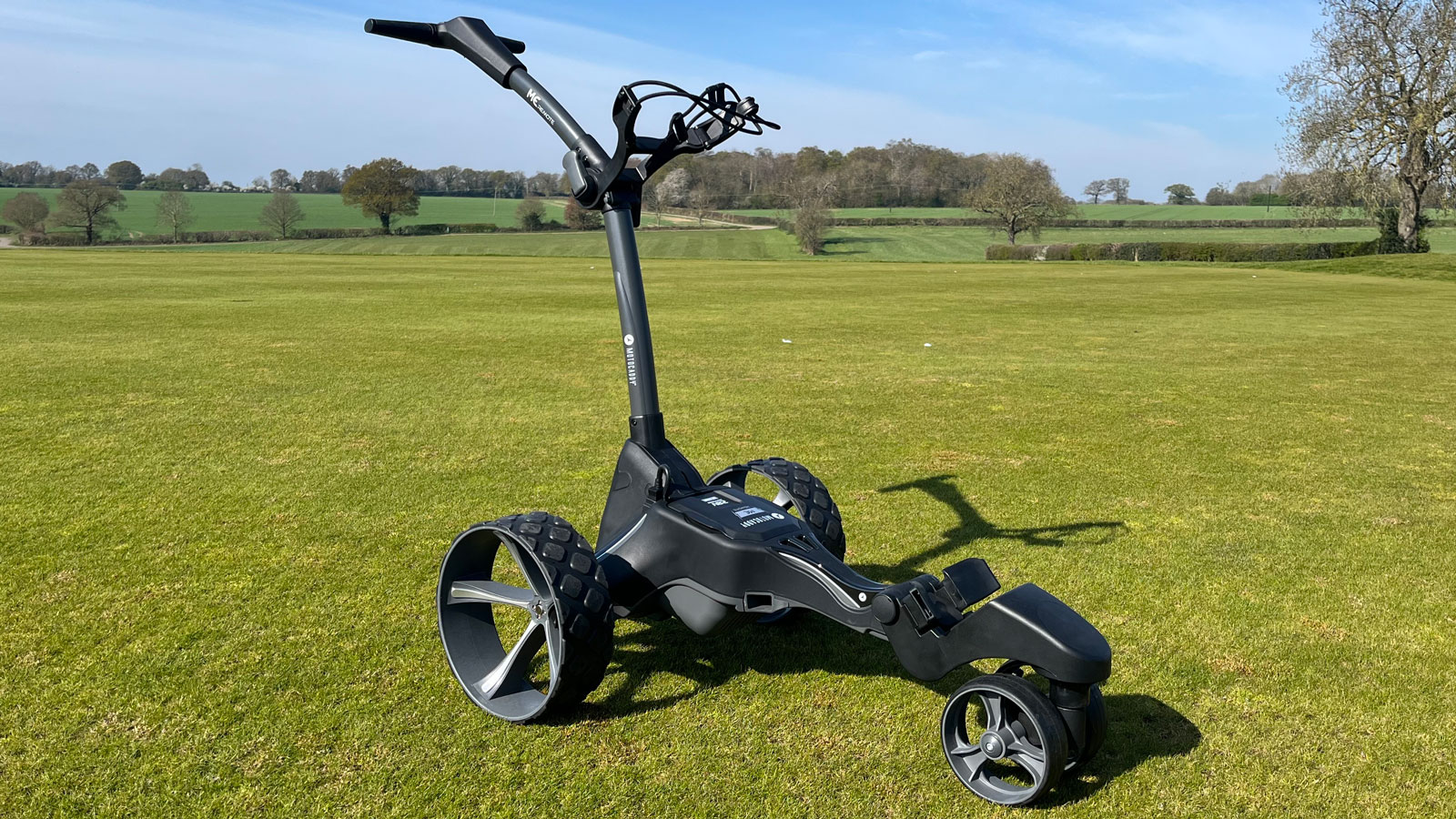
Specifications
Reasons to buy
Reasons to avoid
Another Motocaddy model to include in this guide is the latest ME model, which is remarkably compact. Despite having the manual anti-tip rear wheel, which has to be removed completely to fold the trolley down fully, the ME performed well. The front wheels fold under the chassis, and the rear wheels can be inverted to save even more space when trying to get it into the back of a car. There's a really useful built-in stand too, which allows the ME to stand up on its own, making storage at home all the more convenient.
Moving to remote functionality, I've tested a lot of models and I can say the ME performance is as good as on any more expensive remote trolley I've tried. The remote is incredibly responsive whilst the emergency stop button stops the trolley immediately too.
Maneuverability was good allowing for quick turns at tight angles, whilst the speed was good as well. It unofrtunately doesn't come with the Automatic Downhill Control feature on more expensive models, so that is something to be aware of, but feature wise I liked the USB charging in the handle.
The battery is interesting here. It is wired so perhaps looks antiquated, and whilst Motocaddy haven't quoted an exact number of holes it can cover, in my testing I managed to use it for 27 holes on one charge.
Overall, this is an impressive product at a great price point considering the rest of the market. If you're happy with focusing solely on the remote functionality and don't need any extras like GPS, the Motocaddy ME is an excellent option.
- Read our full Motocaddy ME Remote Electric Trolley
Most unique
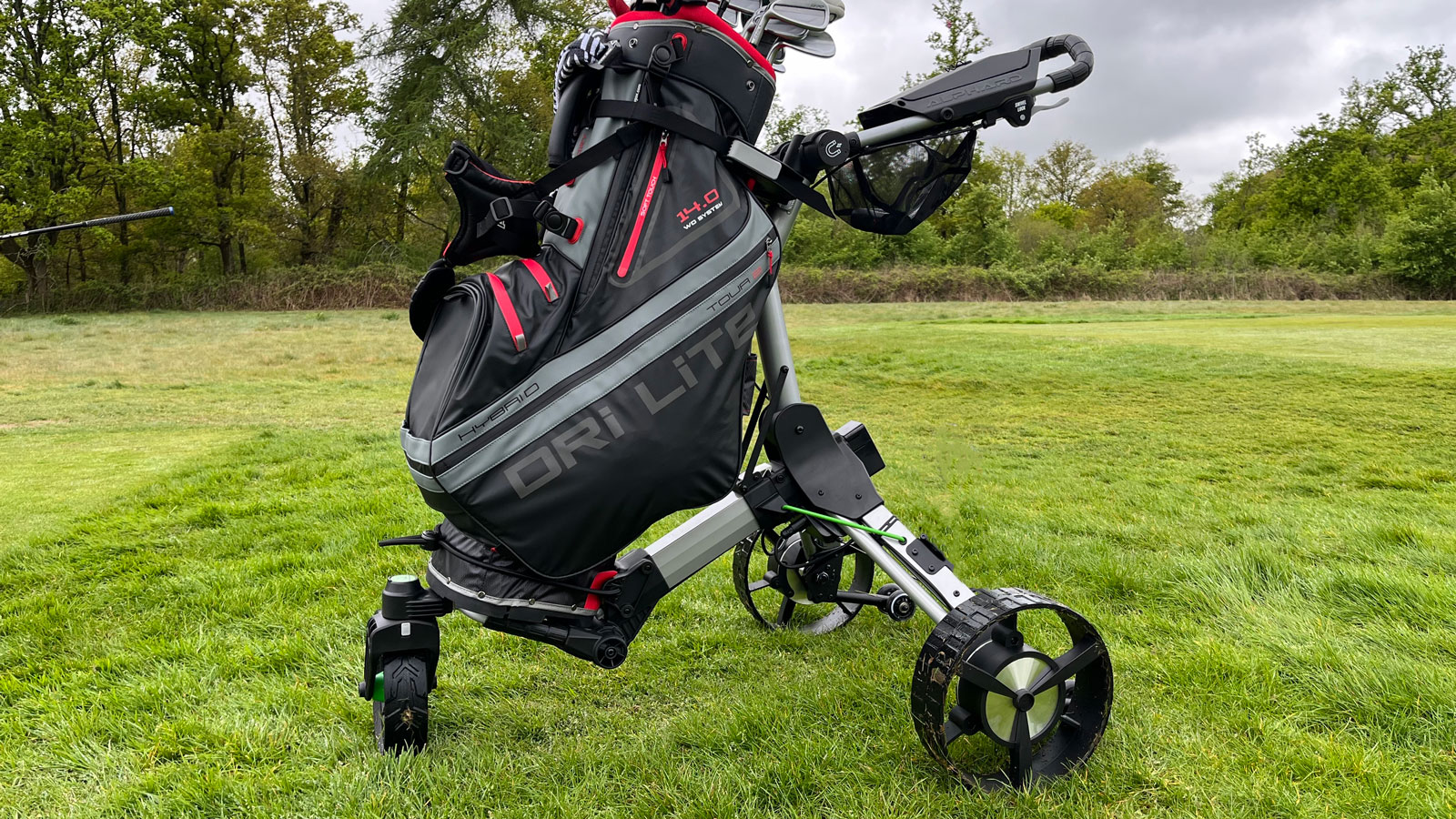
Specifications
Reasons to buy
Reasons to avoid
I hate to start with the negative but the first thing to mention with the Alphart Cybercart is the weight. All in all, it comes in at 18kg, which is roughly 4kg heavier than most of the other models on this list. This does mean many will struggle moving it from the car and I should note assembly was a slightly complex procedure too. The wheels needed to be attached manually and the sheer height of the unfolded trolley took up a lot of space. Indeed that footprint continues when fully assembled which takes a bit of time to get used to, but has a huge advantage as well.
I was most impressed with how the Cybercart handled itself on tough terrain and slopes. Such is the height and width of the chassis, it has a ground-hugging center of gravity that allows it to remain stable and run true over the bumpiest of terrain. When traversing a side slope, the gyroscope built into the system keeps the trolley going in the exact line you want it to. The remote functionality is second only to the Vertx above as well, thanks to an incredibly responsive performance.
Additionally once fully assembled the folding mechanism is a one-step system that I learned quickly whilst the elasticated bungee straps that hold the bag in place are well-made too and can be easily adjusted to securely fasten a big or small bag into the trolley.
Overall I was amazed at how much I enjoyed testing this trolley. The trolley had a real battle on its hands winning me over after my initial experiences with it, and it won. Just steer clear if you want a lighter model.
- Read our full Alphard Cybercart Review
Easy to use

Specifications
Reasons to buy
Reasons to avoid
What makes a remote control golf trolley easy to use? First there’s the ability to fold it up and down without issue. Then there’s the performance out on the course. In both areas, the Q Follow excels.
I found that the new frame design resulted in a really compact trolley when folded down. Getting there was a breeze too. Folding it down requires just two buttons and the battery and handset remained securely in place during the process. I also appreciated that it can be stored vertically, which helps if saving space is an issue.
Out on the course, the Q Follow was just as straightforward to use. The Bluetooth handset makes for a genuinely pleasurable hands-free experience, with the trolley following you around at a sensible distance. However, if required, you can switch from Follow mode to Remote, allowing you to take more control when needed. I found this handy when sending the trolley ahead of us to the next tee.
Stability was equally impressive. The wide front wheel base translates to a design that seems to almost hug the ground. I never had any concern that it would tip over despite its weight. All-in-all it makes for an innovative trolley that’s enjoyable to use..
- Read our full Stewart Golf Q Follow Electric Trolley Review
Best screen
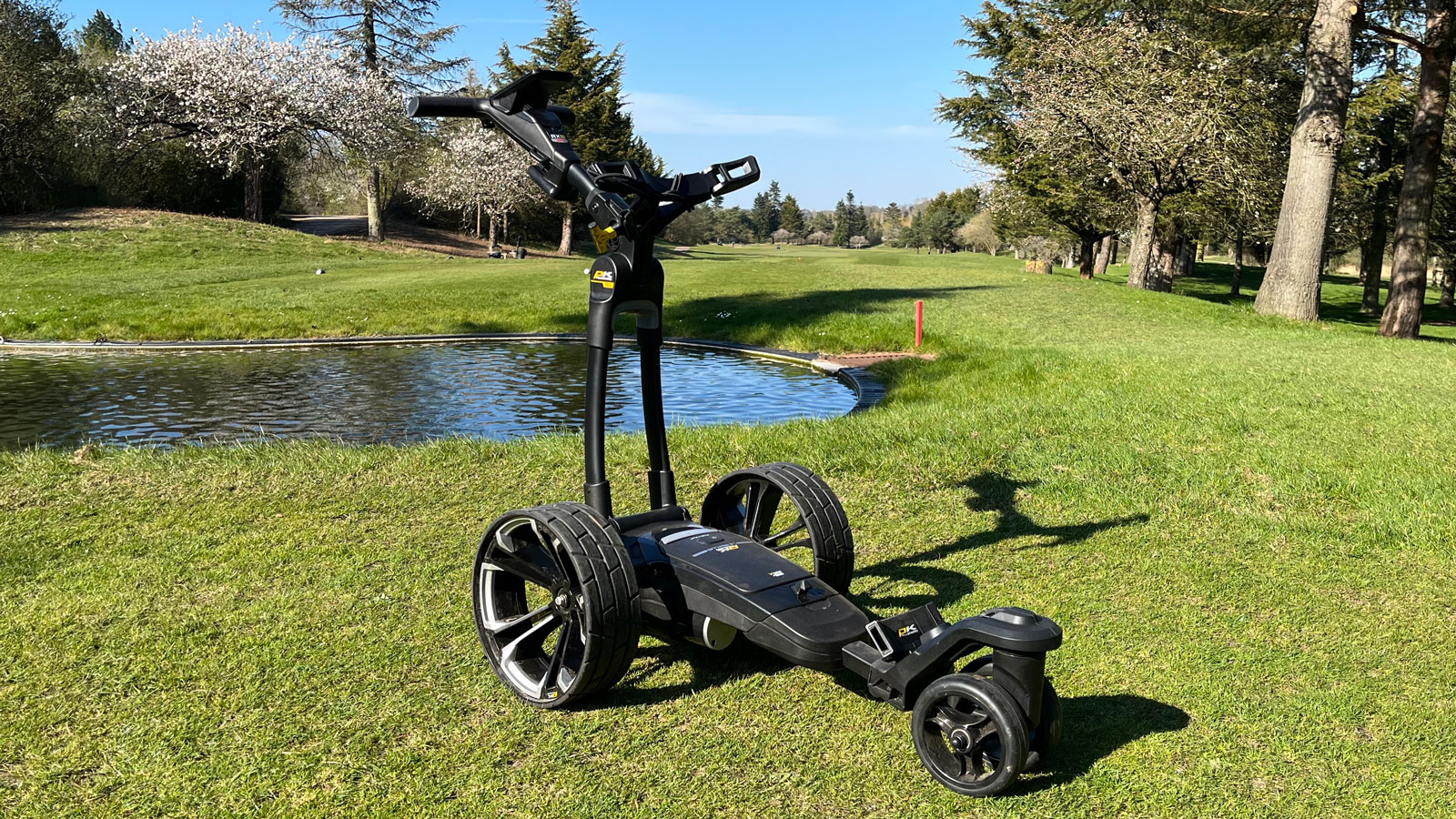
Specifications
Reasons to buy
Reasons to avoid
The biggest selling point the RX12 trolley from PowaKaddy is the 5" HD screen, arguably the best I've seen in my time reviewing electric trolleys. The brand have switched the screen from landscape to portrait which makes perfect sense given the shape of the holes we play and now it couldn't be easier to use your mini caddie while out on the course. It gives yardages to the front, middle and back of greens, yardages to hazards, the ability to drag and drop the pin, a scorecard, performance tracking (fairways hit, greens hit, putts per hole) and a shot measurer. The screen is super powerful as well, powered by a a 1.1GHz processor that means it's as responsive as a premium smartphone.
The remote functionality is complimented by a new and improved remote control, a big upgrade from the rather clunky one I got with the previous RX1 trolley. In all honesty, the performance in this category might not be to the levels of other trolleys on this list as I found that it needed to odd bit of input to keep it driving straight during testing. It also isn't as well equipped to deal with uneven lies and hills as well as some competitors.
Despite this, it remains a fantastic option for the golfer who wants their trolley to follow them around the course whilst also helping them plot their way around with hole previews and accurate yardage numbers courtesy of one of the best trolley screens on the market.
- Read our full PowaKaddy RX12 GPS Electric Trolley Review
Specifications table
Model | Weight | Pre-loaded courses | Screen | Battery |
Stewart Golf Vertx Remote Cart | 14.90kg/32.8lbs | N/A | N/A | Lithium (27 or 45 holes available) |
Motocaddy 2025 M7 GPS Remote Electric Trolley | 14.90kg/32.8lbs | 40,000 | Crystal clear 3.5” LCD touchscreen display | 28V Lithium battery |
Motocaddy ME Remote Electric Trolley | 13kg/28lbs | N/A | N/A | Lithium |
Alphard Cybercart | 18kg/39lbs | N/A | N/A | 37V Lithium battery |
Stewart Golf Q Follow Trolley | 14kg/31lbs | N/A | N/A | Lithium (18 or 36 holes available) |
PowaKaddy RX12 GPS Electric Trolley | 14kg/31lbs | 40,000 | 5” HD portrait touch display | 30V Lithium battery |
How we test
As with all the products we review, we test golf trolleys in a comprehensive fashion. To gain a thorough understanding of their capabilities we take them out on to the course. Here we assess their performance for ease of use, maneuverability, stability and more. We also take in a range of conditions so we can appreciate how a trolley fairs during different seasons.

Dan Parker testing a Stewart Golf trolley
Specifically, this testing takes place over a number of rounds because just by playing we get see how usable a model is day to day - how easy is it to setup, attach the golf bag, or even get out of the car? By playing we also test how well specific models move, which terrain does a specific model perform well or poorly, how responsive is the remote and how much range does it have? All of these types of questions we answer by testing models thoroughly.

Specific trolley testing is overseen by Staff Writer Dan Parker who has been putting models to the test for several years now. Again, as with all reviews, the opinions you read here are formed through rigorous testing and thoughtful evaluation only - a good review can never be bought at Golf Monthly.
How to choose a new golf cart
The trolley market is a pretty crowded place. It can make choosing the right cart for you tricky. Hopefully the above reviews have been a great help but here are a few considerations to think about before you buy.
Push or electric cart?
The choice here may be governed slowly by budget - push carts are simply less expensive than their electric counterparts. Similarly if you need your trolley to be compact and easy to store - maybe the trunk of your car is small or your garage has limited space - then push trolleys are typically lighter and smaller when folded down. If your home course is pretty flat then a push cart also might be all that you require.
In contrast, electric, remote and follow models are larger and more expensive due to the in-built technology. That said they’re a great fit for courses that present a challenging walk. Remote models, as reviewed in this guide, allow for wireless control and can make a round more enjoyable. Follow models help deliver a hands-free experience, which can help save energy over the course of a round.
Weight
Naturally the remote electric technology means that these trolleys are heavier than a traditional push cart. But even so, you’ll need to be able to comfortably get the trolley in and out of your car. Look for models that have carry handles as well as considering the overall weight of the trolley.
Folding
Without electrics and batteries, push carts can fold down into impressively small sizes. If space at home, or in the car, is limited then you might be best to consider a push trolley. That said, if you’re sold on a remote control model then there are some designs that result in a more compact product when folded. Taking a look at a number of models to see how they compare when folded is the best way to assess the right model for you.
Maneuverability
All golf trolleys need to be able to move well and this is especially important for remote models, with stability being vital as well. In our testing we have found three-wheel models to offer both of these factors, however there are some good four-wheeled models too, such as the Stewart Golf trolleys we mentioned above.
Budget
By their very nature the best remote control golf trolleys are more expensive than push models. But within this category prices vary, too. We’ve highlighted a ‘best value’ model in this guide and it’s certainly worth doing your research to find the best model and the right price.
FAQs
How much does a remote control golf cart cost?
A remote model is certainly more expensive than a non-remote. The cheapest remote model start at around $800 and will go up to around $2500.
We hope you enjoyed this guide on best remote golf trolleys. For more trolley buying advice, be sure to have a read of the best value golf push carts, or best affordable golf carts guides.
Subscribe to the Golf Monthly newsletter to stay up to date with all the latest tour news, equipment news, reviews, head-to-heads and buyer’s guides from our team of experienced experts.

Dan has been with the Golf Monthly team since 2021. He graduated with a Master's degree in International Journalism from the University of Sussex and looks after equipment reviews and buying guides, specializing in golf shoes, golf bags, golf trolleys, and apparel reviews. Dan is also a co-host of Kick Point: The Golf Gear Show. A left-handed golfer, his handicap index is currently 7.1, and he plays at Fulford Heath Golf Club in the West Midlands.
Dan's current What's In The Bag:
Driver: Cobra DS-Adapt X
Mini driver: TaylorMade R7 Quad Mini
Fairway: Ping G440 Max 21°
Irons: Titleist T250 (5), Titleist T100 (6-PW)
Wedges: Ping Glide Forged Pro (50, 56, 60)
Putter: TaylorMade Spider Tour X
Ball: Titleist Pro V1x
Grip: Golf Pride Tour Velvet
Bag: Vessel Sunday III
- Conor KeenanEcommerce Writer
- Sam TremlettSenior E-commerce Editor